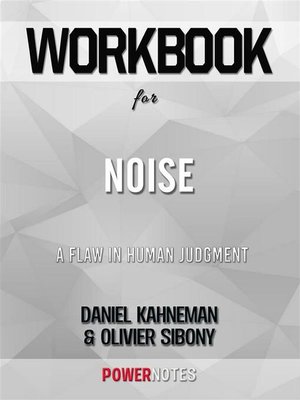

Seeking a more definitive analysis of decision interference in the judicial system, researchers gathered a group of 208 judges and presented them with 16 individual cases. When researchers apply a more statistical analysis to the process of decision-making, assigning numbers to the noise, they can listen to its volume and learn to distinguish its incongruous sounds.Īnother 1981 “noise audit,” or an examination in which many people address parallel decisions, reveals the content of disruptive noise. Noise, on the other hand, is more statistical in nature, making it more difficult to grasp. According to the authors, reality appears to people as a string of causes and effects. And yet, this unavoidable interference seems almost nonexistent to decision makers for various reasons. After all, no person is a soundproof command center, executing seamless choices freed from outer influence and inner misconception. Noise abounds in both the most minute and the most influential spheres of judgment. These instances of decision interference can be silently detrimental, corrupting systems that are designed to be equitable in all circumstances at all times-even if it isn’t a defendant’s birthday.

Though the noise beneath our decision-making can be difficult to hear, its influence is obvious when researchers look at the evidence.
NOISE A FLAW IN HUMAN JUDGMENT TRIAL
A large study from France proved that when a trial date landed on a defendant’s birthday, she was more likely to receive positive news from the judge-a courtroom birthday gift even more welcome than a cake covered in candles. If you do have to pay a visit to your local judge though, you may want to do it on your birthday. Evidently, a regional team’s game-day blunder took a steep toll on people in the courtroom thereafter. A comprehensive 30-year study of 1.5 million judges showed a disturbing correlation between negative outcomes of recent local football games and stricter trial sentences. Thankfully, the sentences in the 1981 experiment were only test cases, but the research grew even more terrifying when these same trends were uncovered in real, everyday courtroom scenarios. These extreme discrepancies garnered a lot of attention. Not only did each of the judges come to completely irreconcilable judgments from the same case material, but they issued disparate sentences too, anywhere from 8.5 years to life in prison. Though each of the judges received the same information as their peers did, in most cases, the conclusions they drew were vastly different. Unfortunately, the experimenters found some pretty bad news for anyone approaching the cold, towering doors of a courtroom. In an evaluation that took place in 1981, experimenters allotted identical cases to judges in order to discern unnecessary discrepancies in their decisions. Frankel’s indictment of the justice system propelled reams of studies throughout the 1970s and 80s, many of which discovered something awry in federal judges’ administration of seemingly neutral sentences. Compelled by the inconsistencies he witnessed inside the courtroom, the renowned Judge Marvin Frankel voiced his concerns throughout the 1970s, publishing a book of his findings entitled Criminal Sentences: Law without Order.

Take the case of the judicial system, one of the more impactful areas of decision-making.

Noise tampers with an individual’s ability to come to fair conclusions, and it can be highly raucous-it’s rarely ever seen and hard to attribute to a single cause. The authors define this kind of “noise” as small but corruptive interferences within decision-making that lead to wide-ranging oversights. And they turn potentially destructive when judges, doctors, and other leaders are the ones calling the shots. Often, these minor considerations maintain a crucial role in decision-making. Do you find yourself easily frustrated on humid days, or especially gracious after lunchtime? While tiny details of daily life may seem inconsequential, studies prove that they aren’t as harmless as they may appear.


 0 kommentar(er)
0 kommentar(er)
